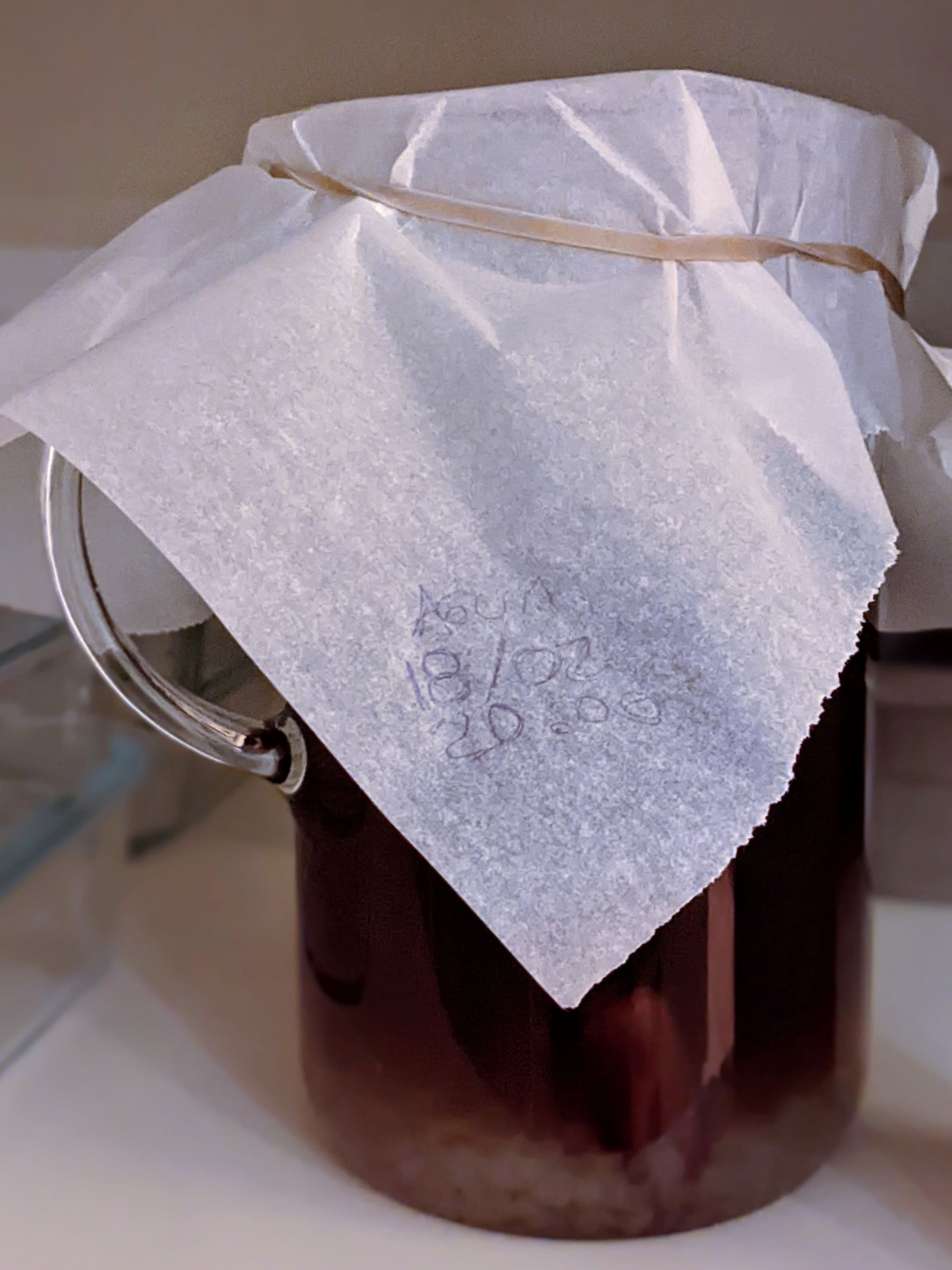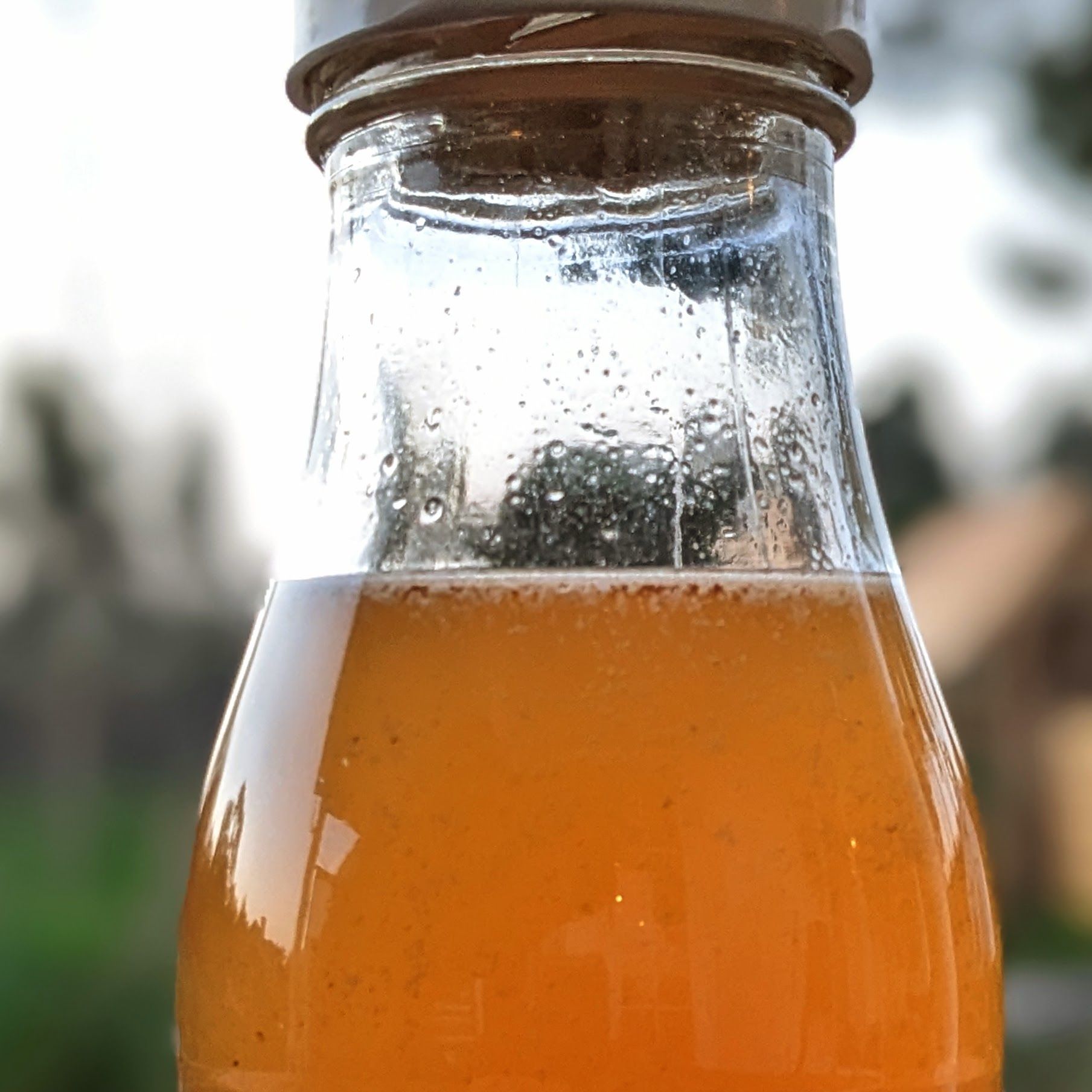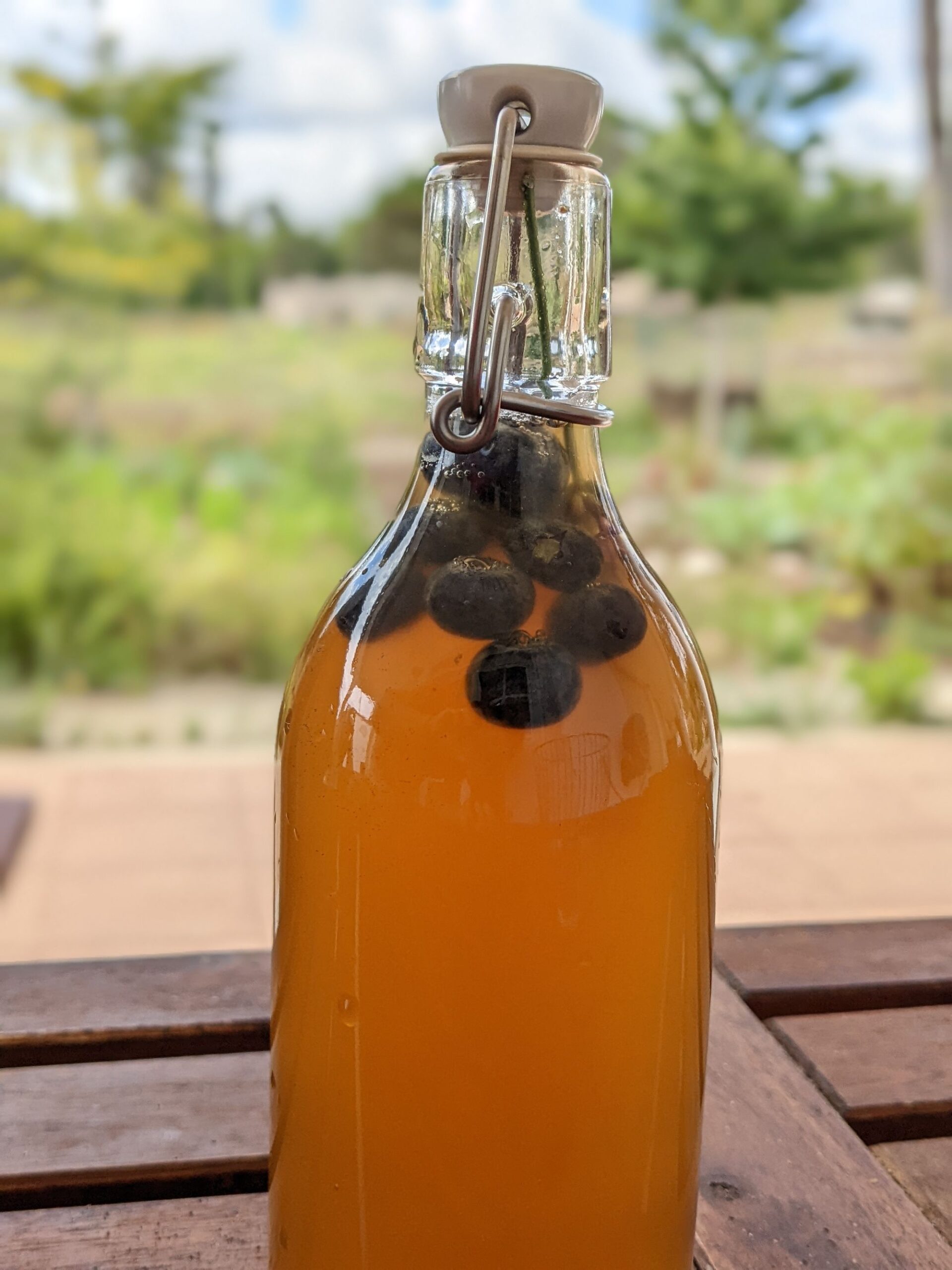If you are looking for a recipe, you should get it right away. Water Kefir benefits and background story are below the recipe. Enjoy!
Recipe
Tools Needed:
- Glass jar, min 1,2L, with an airtight lid.
- Cheesecloth or other breathable material. It must be tight enough to prevent any bugs or dust to enter. An elastic band or other material to secure the cheesecloth to the jar
- A strainer, made of stainless steel or plastic
Ingredients:
- 1L: Filtered or spring water – avoid tap water as chlorine or other substances in that water may harm the kefir
- 4 Tablespoons of organic sugar. This will be the kefir grains food and most of it will be processed by the time you enjoy it. You can use white sugar, but brown sugar and coconut might add some trace beneficial nutrients. Many syrups won’t work as food for the kefir grains, neither will sweeteners. Honey can be downright harmful.
- 4 Tablespoons Kefir grains
Instructions:
1. Obtain Kefir Grains
These are live culture, so you want to get the freshest and best kept product you can find.
2. Gather Tools and Ingredients
You will need a fermentation jar, a cloth cover, and your selected ingredients
3. Prepare Sugar Water
Warm up some water to around 40C and add your selected sugar to dissolve. Pour the liquid into the jar. Add any nutrient-rich food you like, such as a small piece of ginger, high quality salt, lemon peel or even sterilized eggshell. Anything with preservatives might harm your kefir.
4. First Fermentation: Add Kefir Grains
Stir in the kefir grains and cover the jar with a cloth and let it ferment for 24-48 hours in a dark place. If you can’t find a spot that is dark, or you worry you might forget it, you can leave it in your kitchen, for example, but with a towel over it, to protect it from the light. Be mindful that temperatures too low (below 18C) will make the fermentation go slow and temperatures too high might harm and kill your grains (18-23Cis the optimal temperature; above 40C is very harmful). You will know it is ready once you start seeing lots of bubble activity and a layer, or small bubbles on the surface.
5. Strain and Bottle
Strain the fermented kefir into an airtight glass jar or bottle. The liquid can be enjoyed immediately, kept in the fridge for 3 days or you can proceed to making a second fermentation.
6. Second Fermentation (optional):
Strain the fermented kefir into bottles for a second fermentation (optional), which creates natural carbonation and allows for creative flavours – just make sure your grains are safely kept in another jar, perhaps already starting a new batch.
Some common flavours to experiment with are: lemon and blueberries, strawberry and mint, lavender, lemon and orange, etc. You can keep them at room temperature for a few hours to speed up fermentation, but then transfer and keep the bottles in the fridge – this is super important to avoid too much pressure building up and exploding! – and enjoy.
Note: Keep the grains!
You can restart a new batch immediately so your kefir doesn’t go hungry. Alternatively, keep it in the fridge where it can hold for a few days or even weeks.
In any case, it should be kept away from direct sunlight at all times.



What is Water Kefir
Ancient Drink
Water kefir dates back to ancient Tibet and Russia. The grains used in fermentation are known as “Japanese crystals” and have a unique blend of bacteria and yeast.
Fizzy and Refreshing
Water kefir is a non-dairy, low sugar, refreshing, and tangy fermented drink that has a mild carbonation. You can make it according to your taste bugs and creativity and use any flavours you would like. Fruits are the most popular choice but herbs, roots, flowers and other options can bring incredible results.
Healthy Elixir
It is a great source of probiotics, vitamins, minerals, and enzymes, which promote gut health, boost the immune system, reduce inflammation and oxidative stress, and improve skin health.



Benefits of Water Kefir
Boost the Immune System
The probiotics in water kefir stimulate the growth of good bacteria in the gut and improve digestion, nutrient absorption, and the production of vitamins.
Reduce Inflammation
Regular consumption of water kefir reduces inflammation, oxidative stress, and pain in the body.
Detoxify the Body
The probiotics, enzymes, and organic acids in water kefir support the liver to detoxify and eliminate toxins from the body.
Improve Skin Health
The lactic acid in kefir exfoliates dead skin cells, balances the pH level, and reduces wrinkles, blemishes, and acne.


Background
This homesteading world is quite exciting. Every day, you get a chance of learning new skills or spot new opportunities. And to top it all up, many of them are ways of making our lives and/or Nature better.
One of the opportunities in the menu is, of course, food. The idea that we can use food as a way to thrive and be healthy is glorious, albeit not new at all. It is such a departure from my relationship with food throughout my life that it still doesn’t come naturally. But natural it is.
The approach we have identified ourselves with the most at the moment is eating good, natural food. No grains, little eggs, no sugar or added salt (particularly for the kids). We do eat meat and fish and some dairy. We try to get it from sustainable sources.
In any case, the idea is that, more and more, our food should come from our garden. We can’t find a better way to make sure it is the healthiest food possible, not only avoiding damage to the environment, but actually making it better. It is a dream goal, but a goal nonetheless.
This requires skills we only like to think we have, such as planning or basic cooking; and many new ones, such as preserving, gardening and raising animals throughout their lifecycle.
As a part of preserving, three four main categories are in focus:
- Cold: we are already using a fridge and a freezer, but there is more to learn, particularly on how to freeze some produce without losing their nutrients.
- Dehydration: we have been experimented with this, but very little, last year. The results were very promising, and we will surely be relying on it more and more. One of the next steps here, apart from having excess product to dehydrate, is a clear way to store afterwards: what kind of containers (avoiding plastic), organization system, to easily find things afterwards.
- Fermenting: the opportunities here and endless and extremely appealing. We have started with a few things, like yogurt and sauerkraut, but there is so much more to explore. This water kefir is just one of the many experiments yet to come.
- Canning: I have mixed feelings about this option. Sure, preserving some things canned is appealing but is it really that much better than freezing? The process appears quite involved and precise in order to avoid disastrous consequences. It seems to require following exact instructions, something that I profoundly dislike, particularly in the kitchen. Beyond dislike, the stress of wondering if I missed something would remove any pleasure of eating that food and just made me worry whenever I shared it with my family. Still, learning more might change my mind.



